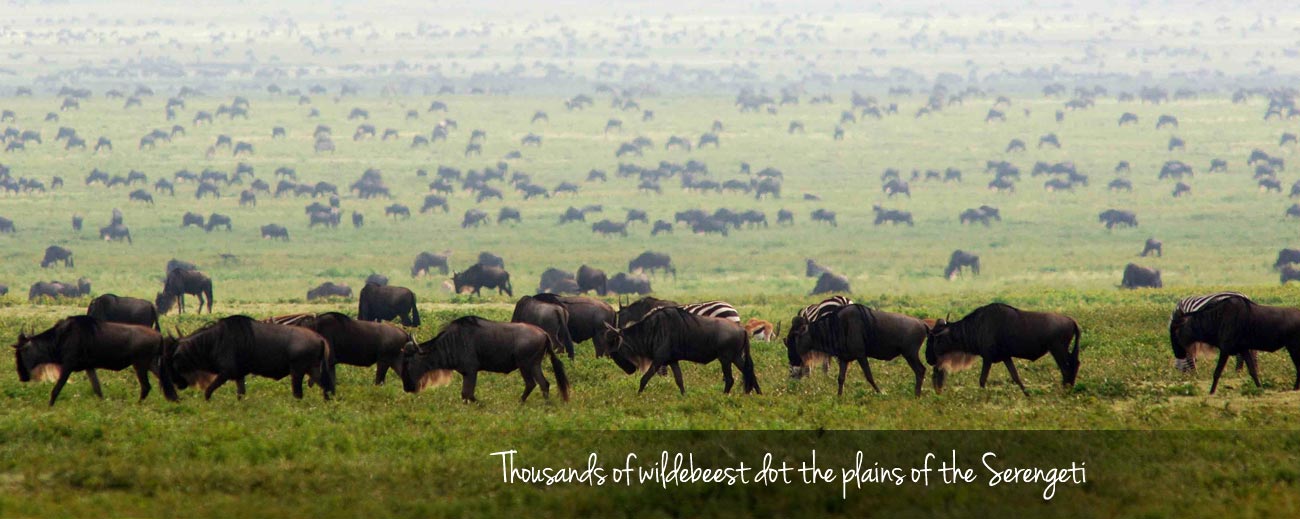
Great Wildebeest Migration guide …
What is the Wildebeest Migration?
One of the last natural wonders left on earth – it is a must-see! You may have seen in films those wide open plains filled with Wildebeest, but until you share the same ground they walk on; you have not experienced the Wildebeest Migration. Annually over two million Wildebeest migrate from Tanzania’s Serenget National Park to the Maasai Mara National Reserve in Kenya. It is an incredible sight! Picture millions of animals surrounding you, or better yet, picture over two million animals running together at such a pace that not even a brick wall could stop them. It is just beautiful.
THE LATEST UPDATE:
Wildebeest river crossings are still happening!
It is estimated that at least half of the herds have arrived in the Mara area, with the balance being in the northern Serengeti in the Lamai area. There are still a few stragglers as far south as the Four Seasons, and they seem to be taking their sweet time in making their move, which ensures some breathtaking game viewing.
The concentration of crossings have been on the Sand River, as well as several crossings on the Mara River, with one of our groups having reported crossings of an estimated 300 000 animals while spending time close to the river.
Predicting the Wildebeest Migration
Predicting the movements of the large herds is not an exact science, as it is governed by the rainfall in certain areas, but with our wealth of knowledge and time spent in the national parks, we are able to make a fairly accurate educated guess.
The Migration is a year round process, and the animals move in a huge circle within the ecosystem. Here is a rough guide on their movements:
Important to Note:
Please note that this is a natural event and there are a number of factors such as rain and availability of food that influences the timing of the migration in its various stages. Like all pure wildlife experiences nothing can be guaranteed. The below is simply a general guide based on past behavior patterns of the great wildebeest migration.
January to March
From January to March the great herds are usually spread out over the vast short grass plains of the Southern Serengeti and Ngorongoro Conservancy. The wildebeest also tend to have their young over a very short period in February. This is a great time to be on safari in Tanzania as not only do you have the opportunity to see the great herds spread out over the plains, but the herds are also in the South and so in close proximity to the other excellent Northern parks of Tarangire, Manyara and the Ngorongoro Crater.
April & May
The long rains tend to start in March and continue until the end of May and with the onset of the rains the Migration begins heading North. The Great Migration Herds tend to split in 2 groups. One group heads West to the Grumeti Region and the other group heads due North passing through the beautiful Moru Kopjes region and in to the central Seronera region.
June to Mid July
The central Serengeti, Seronera area is a fantastic place to see the predators, especially the huge Lion prides and the area explodes with activity around early June when the migration makes its way onto the fresh grasslands. A Serengeti Safari is excellent in the Seronera area at this time.
The Western Corridor (Western Serengeti) is a more exclusive safari area and a prime location for the migration from mid June to July, before these massive herds also head North East for the Mara River and the Masai Mara.
July to October
The massive herds start to accumulate on the banks of the crocodile infested Mara River from mid-July. Even though by September most of the herds have crossed over the Mara River and into the Masai Mara, many herds cross back and forth over the Mara River and so the Northern Serengeti at this time is still a great place to be. Seeing the massive herds in the Masai Mara is also an awesome experience
November to January
The herds tend to remain in this region up until mid October/November when the herds start heading south again and finally reach the open plains of the southern Serengeti by January.
Special Note:
Witnessing this most unbelievable of natural wonders has to be the most remarkable safari experience there is, but good planning and local knowledge is essential in maximizing your experience. This is where Realm Africa Safaris’ specialist consultant can assist you in planning an unforgettable safari to the Serengeti and/or Masai Mara to witness the Great Wildebeest Migration.

